Physical Address
304 North Cardinal St.
Dorchester Center, MA 02124
A retrospective review of the United Network for Organ Sharing Database (UNOS) from 1987–2012 recently estimated that over 2 million life-years have been saved by solid organ transplant, including both adult and pediatric patients. The ability to successfully perform solid organ transplantation in children has led to a remarkable improvement in survival and quality of life. In this chapter, each of the abdominal solid organ transplant procedures will be discussed, including the indications, operative procedure, and postoperative complications relevant to the practicing pediatric surgeon.
Few subspecialties have undergone the dramatic improvements in survival that have occurred in pediatric liver transplantation (LT). In the early 1980s, survival rates of 30% limited the enthusiasm for this costly, work-intensive endeavor. The introduction of more effective immunosuppression along with refinements in the operative and postoperative management of infants and children has led to survival rates greater than 90%. Challenges remain, including the need for donor organs suitable for pediatric recipients of all ages and sizes, the optimization of the pretransplant patient physiology to increase peri-transplant survival, and the improvement in long-term quality of life (QOL).
The most common clinical presentations prompting transplant evaluation in children can be classified as (1) primary liver disease with the expected outcome of hepatic failure, (2) chronic liver disease with significant morbidity or known mortality, (3) hepatic-based metabolic disease, (4) fulminant hepatic failure, and (5) hepatic neoplasms such as a malignancy (i.e., hepatoblastoma, where the tumor is not resectable by conventional means) or a vascular malformation in which extensive arteriovenous shunting causes irreversible heart failure.
Table 45.1 reviews the major diagnoses that lead to LT. These disease entities define the bimodal age distribution of pediatric transplant recipients. Infants and children with biliary atresia (BA) and, occasionally, rapidly progressive hepatic failure secondary to metabolic abnormalities, such as neonatal tyrosinemia, hemochromatosis, and hepatic tumors, are the patients who require transplantation early in life. Patients with metabolic disturbances, fulminant hepatic failure, and cirrhosis present as older children and adolescents requiring LT.
| Diagnosis | No. of Patients | Percentage (%) |
|---|---|---|
| Alagille syndrome | 20 | 3.6 |
| Autoimmune hepatitis | 3 | 0.5 |
| Biliary atresia | 232 | 41.3 |
| Cholestatic liver disease | 12 | 2.1 |
| Cirrhosis | 20 | 3.6 |
| Cystic fibrosis | 4 | 0.7 |
| Fulminant liver failure | 80 | 14.2 |
| Hemangioendothelioma | 3 | 0.5 |
| Hepatoblastoma/tumor | 47 | 8.4 |
| Metabolic disease—glycogen storage disease | 5 | 0.9 |
| Metabolic disease—other | 20 | 3.6 |
| Metabolic disease—primary hyperoxaluria | 4 | 0.7 |
| Metabolic disease—tyrosinemia | 7 | 1.2 |
| Metabolic disease—urea cycle defects | 4 | 0.7 |
| Metabolic disease—Wilson disease | 4 | 0.7 |
| Metabolic disease—α1-antitrypsin deficiency | 36 | 6.4 |
| Other | 21 | 3.7 |
| Other tumor | 2 | 0.4 |
| Progressive familial intrahepatic cholestasis | 9 | 1.6 |
| Primary liver malignancy—other malignancy | 8 | 1.4 |
| Primary sclerosing cholangitis | 16 | 2.8 |
| TPN/Short gut | 5 | 0.9 |
| Total—primary transplant | 562 | 100 |
| Retransplant | 68 | |
| Total Liver Transplants | 630 |
Children with extrahepatic BA constitute at least 50% of the pediatric LT population. Successful biliary drainage achieving an anicteric state following the Kasai portoenterostomy is the most important factor affecting preservation of liver function and long-term survival and precludes transplantation in infancy and early childhood. Primary transplantation without portoenterostomy is not recommended in patients with BA unless the initial presentation is at an age greater than 120 days and a liver biopsy shows advanced cirrhosis. Patients with progressive disease following a Kasai procedure should be offered timely orthotopic liver transplantation (OLT). The sequential use of portoenterostomy and LT optimizes overall survival and organ use.
Patients with extrahepatic BA who are seen for transplantation form several cohorts. Infants with a failed Kasai have recurrent cholangitis, ascites, rapidly progressive portal hypertension, malnutrition, and progressive hepatic synthetic failure. This cohort requires OLT within the first 2 years of life. Children with the successful establishment of biliary drainage have improved survival with their native liver, but successful drainage does not preclude the development of cirrhosis and portal hypertension leading to hypersplenism, variceal hemorrhage, ascites, and occasionally hepatopulmonary syndrome. These patients require LT later in childhood. Patients with mild hepatocellular enzyme and bilirubin elevation and mild portal hypertension can be observed with ongoing medical therapy. Currently, long-term follow-up studies indicate that virtually all patients with BA will ultimately require OLT at some point in their life.
Alagille syndrome (angiohepatic dysplasia) is an autosomal dominant genetic disorder that manifests as bile duct paucity that leads to progressive cholestasis, pruritus, xanthomas, malnutrition, and growth failure. Liver failure occurs at varying time points, with criteria for LT being the typical manifestations of chronic liver disease—complications of portal hypertension and growth failure. QOL issues such as intractable pruritus, hypercholesterolemia, and intractable bone disease are criteria for consideration for LT. Preoperative evaluation must include assessment for congenital cardiac disease and renal insufficiency, both of which are associated with this syndrome. Hepatocellular carcinoma (HCC) has also been reported in Alagille disease.
Experience using external biliary diversion or internal ileal bypass accompanied by ursodeoxycholic acid therapy has demonstrated a significant decrease in both pruritus and complications of hypercholesterolemia. A recent report summarizing the biliary diversion experience from a multi-institutional consortium indicates that bypass relieves pruritus. New treatment strategies have been developed addressing pruritus and hold promise in mitigating the need for LT for this QOL issue.
An important indication for LT in older children is hepatic-based metabolic disease. In these patients, LT is not only lifesaving but also accomplishes phenotypic and functional cure. A review of these diseases and their mode of presentation is given in Box 45.1 and Table 45.2 .
Wilson disease
α1-Antitrypsin deficiency
Crigler–Najjar syndrome (type I)
Tyrosinemia
Cystic fibrosis
Glycogen storage disease type IV
Branched-chain amino acid catabolism disorders
Hemophilia A
Protoporphyria
Homozygous hypercholesterolemia
Urea cycle enzyme deficiencies
Primary hyperoxaluria
Iron storage disease
| Cirrhosis | Liver Tumor | Life-Threatening Progressive Liver Disease | Failure of Secondary Organ, Normal Liver |
|---|---|---|---|
| α1-Antitrypsin deficiency Wilson disease Hemochromatosis Byler disease Cystic fibrosis Tyrosinemia GSD type IV FHD EPP |
Tyrosinemia GSD type I Galactosemia FHD Hemochromatosis α1-Antitrypsin deficiency |
Urea cycle defect Protein C deficiency Crigler–Najjar syndrome type 1 Niemann–Pick disease Hemochromatosis Tyrosinemia BCAA |
Type 1 hyperoxalosis Hypercholesterolemia |
Hepatic replacement to correct the metabolic defect should be considered before other organ systems are affected and before complications develop that would preclude transplantation, such as in patients with tyrosinemia, in whom there is a high risk of HCC. Although results of transplantation are excellent in the metabolic disease subgroup, replacement of the entire liver in order to correct single enzyme deficiencies is an inefficient but presently necessary procedure. Ongoing research centers around hepatocyte transplantation and gene therapy but to date has not demonstrated durable efficacy. Patients with primarily extrahepatic manifestations of their disease, such as cystic fibrosis, are occasionally helped by LT, although their prognosis is most often determined by their primary illness.
Patients with fulminant hepatic failure without recognized antecedent liver disease are a challenging cohort of patients. Rapid clinical deterioration frequently makes establishment of a defined cause impossible before there is an urgent need for transplantation. In a multi-institutional manner, the pediatric acute liver failure (ALF) consortium established in 2003 has improved the diagnostic approaches and has better characterized the disease process. Acute liver failure of undefined etiology followed by drug toxicity and toxin exposure are the most common causes of ALF. Previously unrecognized metabolic disease also must be considered. An immune-based defect has been recognized as a cause of fulminant liver failure. This population needs to be identified as these children may require a combination of bone marrow and LT to achieve long-term survival. When acceptable clinical and metabolic stability make liver biopsy safe, diagnostic information allowing directed treatment of the primary liver disease is helpful. The presence of ongoing coagulopathy often dictates the need for an open approach to biopsy.
The prognosis of patients with fulminant liver failure is difficult to predict, and neurologic outcome is potentially suboptimal. Use of intracranial pressure (ICP) monitoring in patients with progressive encephalopathy has allowed early recognition and treatment for increased ICP. Monitoring should be considered for patients with advancing grade III encephalopathy and in all patients with grade IV encephalopathy. Intracranial monitoring is continued intraoperatively and for 24–48 hours after OLT, because significant increases in ICP can develop during these periods. Failure to maintain a cerebral perfusion pressure greater than 50 mmHg and an ICP less than 20 mmHg has been associated with very poor neurologic outcomes. Efforts to identify and perform LT in children before this deterioration occurs are of utmost importance. ICP monitoring has risks, and intracranial bleeding can occur. When candidates are identified before they develop irreversible neurologic abnormalities, the results of transplantation are dramatic.
Transplantation for hepatoblastoma is recommended for individuals who, after the administration of several cycles of chemotherapy, have a neoplasm confined to the liver that is unresectable. Children who had prior isolated metastasis that disappeared while undergoing preoperative chemotherapy are also transplant candidates. A favorable response to pretransplant chemotherapy suggests a more favorable long-term outcome. In the recently completed Children’s Oncology Group (COG) trial AHEP 0731, early referral for transplant evaluation was evaluated for children who presented with large lesions that appeared unresectable and was found to be an effective strategy that appears to have improved survival.
Transplantation for HCC is complicated by less successful chemotherapy options and frequent extrahepatic involvement. The reported 2-year survival rates are only 20–30%. Most deaths are due to recurrent HCC within the allograft or to extrahepatic tumor involvement. When primary HCC is discovered incidentally within a cirrhotic explant, the overall prognosis is unaffected by the tumor. Recent attention has focused on whether adult HCC Milan criteria for transplantation apply to the pediatric HCC population. In the soon-to-open Pediatric Hepatic International Tumor Trial, there are two treatment arms for the pediatric patient with HCC with transplantation as a part of the treatment strategy. From this study, it is hoped that a better understanding of pediatric HCC will be established and better treatment strategies will result.
Vascular tumors represent a group of patients with diffuse pathology who can benefit from transplantation. Children with progressive, intractable congestive heart failure, even when caused by non-neoplastic arteriovenous malformations or diffuse hemangiomas, offer a unique opportunity for complete removal of the vascular malformation and correction of congestive heart failure. Transplantation in these instances in our experience offers significantly better long-term survival compared with embolization or hepatic artery occlusion, which can precipitate sudden and widespread hepatic necrosis. Pretransplant biopsy is essential in large or complex lesions to exclude angiosarcoma.
Contraindications to LT include extrahepatic unresectable malignancy, malignancy metastatic to the liver, progressive terminal nonhepatic disease, uncontrolled systemic sepsis, and irreversible neurologic injury.
Relative contraindications to LT that need to be individually evaluated include advanced or partially treated systemic infection, advanced hepatic encephalopathy (grade IV), severe psychosocial difficulties, portal venous thrombosis extending throughout the mesenteric venous system, and serology positive for human immunodeficiency virus.
The single factor that continues to limit the availability of LT is the supply of donor organs. In the United States, the number of patients awaiting LT is typically between 14,000 and 15,000 patients per year. Typically, there are 8–10,000 deceased donors. As a consequence, the waiting time to transplant for all age groups is significant with persistent waiting list mortality. Young children and infants continue to have the highest waiting list mortality ( Fig. 45.1 ).
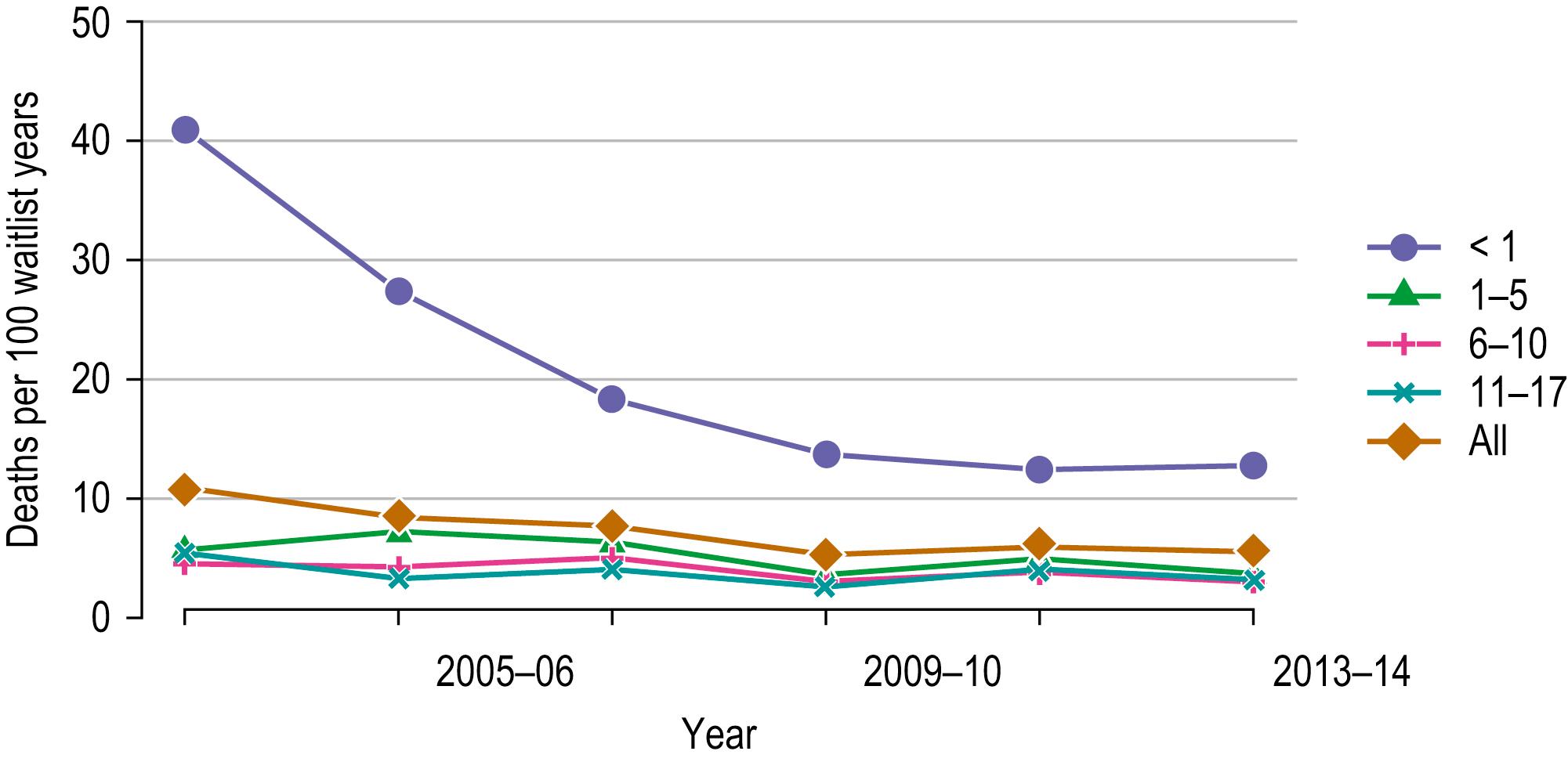
The limited supply of available donor organs has driven the advancement of many innovative liver transplant surgical procedures. The development of reduced-size LT allowed significant expansion of the donor pool for infants and small children. This not only has improved the availability of donor organs but has also allowed access to donors with improved stability and organ function. Evolution of these operative techniques has resulted in the development of both split-LT and live donor (LD) transplantation. In the hands of experienced transplant teams, these procedures all have success similar to that with whole organ transplantation.
In 1998 the “final rule” established by the Health Resources and Service Administration mandated the formation of a system for candidate stratification based on a continuous severity score reflecting 90-day waiting list mortality (i.e., outcome). The system for pediatric patients, the Pediatric End-Stage Liver Disease (PELD) score, was created using an analysis of the prospective registry of children listed for transplantation by the consortium Studies of Pediatric Liver Transplantation (SPLIT). The parameters selected included total bilirubin, international normalized ratio (INR), albumin, age younger than 1 year, and evidence of failure to thrive ( Box 45.2 ). The primary function of PELD is the stratification of candidates for LT by risk of 90-day waiting list mortality, allowing optimal use of donor organs. When death rates for all children listed were analyzed, PELD was an accurate predictor of mortality risk and demonstrated progressive risk until high scores were reached (>35) ( Fig. 45.2 ).
Age: Age <1, score = 1; age >1, score = 0.
Growth failure: Growth >2 standard deviations below mean, score = 1; growth <2 standard deviations below mean, score = 0.
Equation based on age, growth, and serum total bilirubin, international normalized ratio, and albumin.
PELD, Pediatric end-stage liver disease.
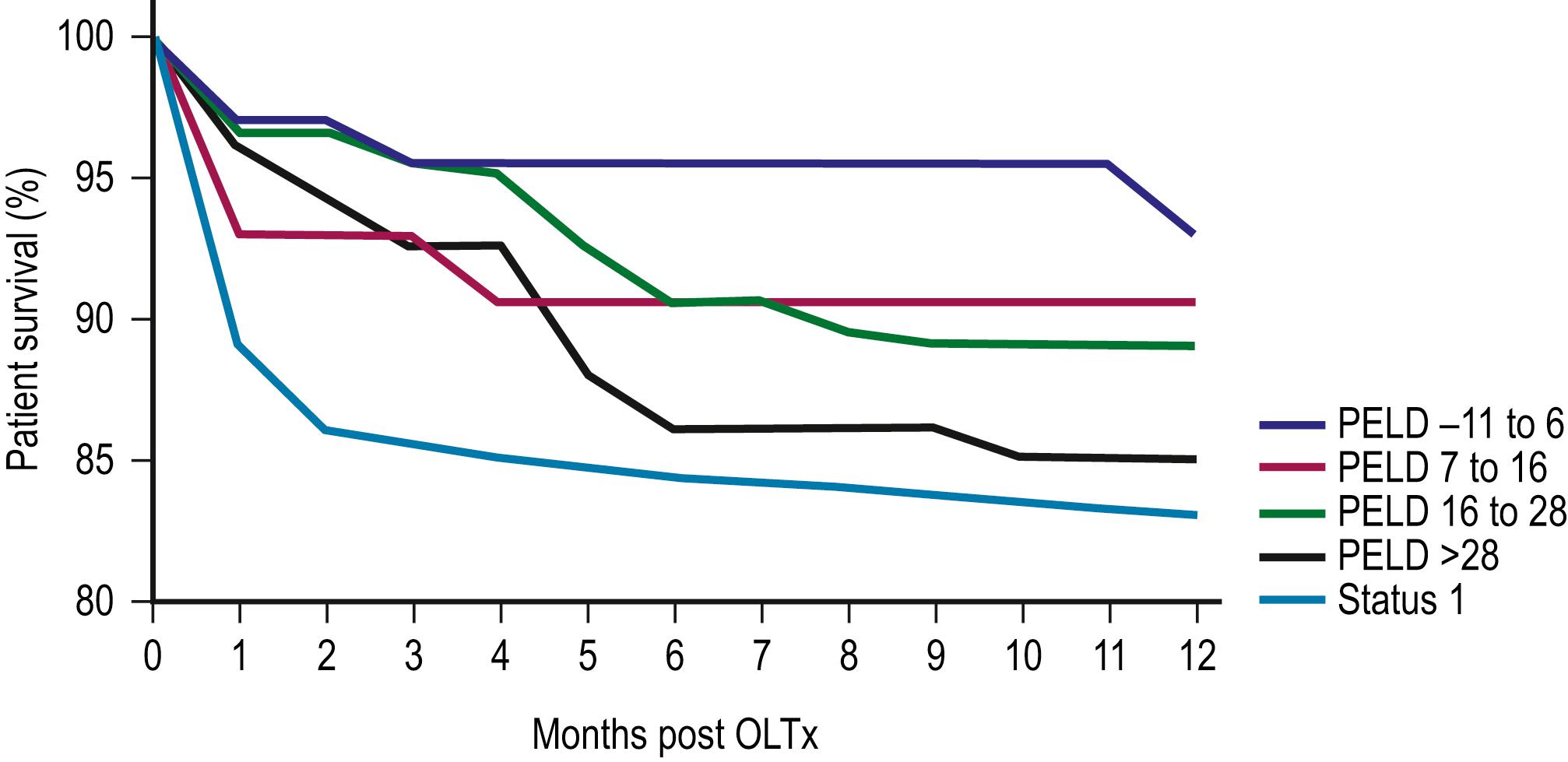
Assessment of donor organ suitability is undertaken by evaluating clinical information, static biochemical tests, and dynamic tests of hepatocellular function. Static biochemical tests identify preexisting functional abnormalities or organ trauma, but do not serve as good benchmarks to differentiate among acceptable and poor donor allografts. Donor liver biopsy is helpful in questionable cases to identify preexisting liver disease or donor liver steatosis. The shortage of donor organs has led to expanded efforts to use individuals of advanced age and marginal stability, termed extended criteria donors (ECDs). The donor risk index (DRI) is used as a guide that quantifies relative risk of graft failure. In the future, organ allocation may be based on maximal life-years gained, an approach being utilized in kidney allocation.
Anatomic replacement of the native liver in the orthotopic position requires selection or surgical preparation of the donor liver to fill but not exceed available space in the recipient. When using full-sized allografts, a donor weight range from 50–125% of the recipient weight is usually appropriate, taking into consideration body habitus and factors that would increase the abdominal size in the recipient, such as ascites and hepatosplenomegaly. The right lobe graft, using segments 5–8, and the right trisegmentectomy graft, using segments 4–8, can be accommodated when the weight difference is no greater than 2:1 between the donor and recipient (D/R). The thickness of the right lobe makes this allograft of limited usefulness in small recipients. The left lobe, using segments 1–4, is applicable with a D/R ratio from 2.5:1–5:1, and a left lateral segment (segments 2 and 3) can be used with up to a 10:1 D/R weight difference.
Although whole organ allografts are preferred, technical variant grafts are commonly employed. Preoperative preparation of variant liver allografts is based on the anatomy of the hepatic vasculature and bile ducts. In the past, reduced-size grafts were common, but because of the donor shortage, split-liver transplantation has become widespread using either an ex situ or in situ approach. The result is two transplantable grafts. The ex situ split procedure divides the right lobe allograft (segments 5–8) from the left lateral segment (LLS) allograft (segments 2 and 3) after the whole donor organ has been procured.
The successful experience with in situ division of the LD LLS is a basis for the in situ split procedure. Two variations of the procedure are utilized depending on the needs of the recipients, a right-left lobe split or a right trisegmentectomy–LLS split. For the right trisegmentectomy–LLS split, the LLS is prepared similar to a living-related donor graft. The viability of segment 4 can be examined at the time of the division and is usually incorporated with the right lobe graft to increase the cellular mass of the allograft. For a left-right lobe graft, the parenchymal resection follows the anatomic lobar plane through the gallbladder fossa to the vena cava. A crush and tie technique is preferred to achieve good closure of the vascular and biliary structures. The bile duct, portal vein, and hepatic artery are divided at the right or left confluence. The vena cava is left incorporated with the allograft in both right and left lobe preparation. Vena caval reduction by posterior caval wall resection and closure is occasionally necessary. Resection of the inferior protruding portion of the caudate lobe is necessary during left lobe preparation to reduce the likelihood of arterial angulation, which can result in arterial thrombosis. This also facilitates shortening of the inferior vena cava to fit in a small recipient. With LLS allografts, the parenchymal dissection follows the right margin of the falciform ligament with preservation of the left hilar structures. Direct implantation of the left hepatic vein into the combined orifice of the right and middle/left hepatic veins in the recipient vena cava is preferred. Further reduction of the LLS graft to a monosegmental graft may be necessary in very small recipients. Resection of the distal LLS is technically easier than an anatomic segment II/III division. Because this procedure adds considerably to the donor procurement time, and the necessary skill of the donor team, it is more demanding and occasionally difficult to successfully orchestrate. This technique is, however, despite these considerations, the preferred method for split-liver donor preparation.
The benefits of split-liver transplantation are best achieved when ideal donors are selected. Strict restrictions on age, vasopressor administration, predonation hepatic function, and limited donor hospitalization have been used to select optimal donor candidates. When these donors are selected, the results from both in situ and ex situ techniques are similar, with both techniques now having patient survival for both allografts of 90–93% and graft survival rates of 86–89%.
The use of LDs has become an integral component of most pediatric transplant programs armamentarium with excellent donor safety profiles ( Fig. 45.3 ). One of the critical elements of LD transplantation is the proper selection of a donor, usually a parent or relative. Careful attention to proper LD consent is important. Parental concerns to help their ill child make true informed consent a challenge. A dedicated donor advocate not directly associated with the transplant team should assist with this process. Independent medical assessment of the donor is essential. UNOS has established clear criteria for this process. After a satisfactory medical and psychological examination by a physician not directly involved with the transplant program, computed tomography (CT) scanning is used to measure the volume of the potential donor segment to ensure it will meet the metabolic needs, but not exceed the space available in the recipient. CT angiography is undertaken to assess the hepatic arterial anatomy, thereby excluding potential donors with multiple arteries to segments 2 and 3 and facilitating minimal hilar vascular dissection at the time of LT.
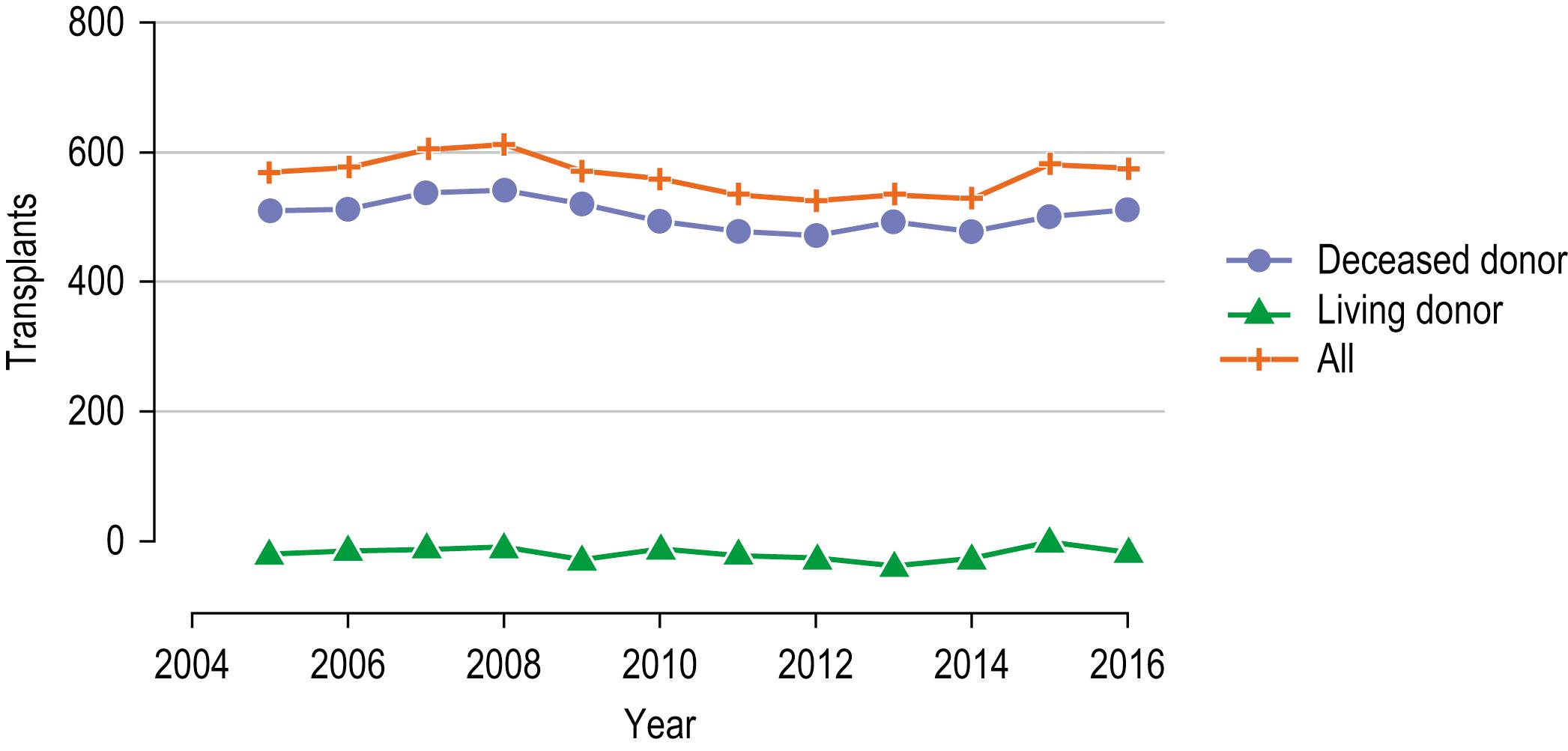
In most pediatric cases, the LLS donated from an adult is used as the graft. In situ dissection of the LLS, preserving the donor vascular integrity until the parenchymal division is completed, is undertaken. At the time of harvest, the left hepatic vein is divided from the vena cava and the left branch of the portal vein and hepatic artery are removed with the allograft. Vascular continuity of the hepatic arterial branches to segment 4 is maintained, if possible. Increased experience has been gained using the right lobe as an LD allograft for larger recipients such as adolescents and adults. This more extensive operation has proven to be a challenge to the donor and recipient alike, with complication and mortality rates significantly exceeding those of left lateral segmentectomy. The number of right lobe LD recipients now greatly exceeds the number of children receiving LD grafts. However, several publicized donor deaths have in the United States tempered the enthusiasm and growth of right lobe donation.
The selection of a donor segment with an appropriate parenchymal mass for adequate function is critical to success. However, the minimal mass necessary for recovery is not yet established. Any calculation must take into account loss of function following preservation damage, acute rejection, and technical problems. Estimates of the ratio of donor graft to recipient body weight (GRWR) may prove to be a more accurate predictor of adequate graft volume. When the GRWR is less than 0.7%, overall allograft and patient survival suffers. In extreme cases in which small-for-size grafts are used, excessive portal flow can lead to hemorrhagic necrosis of the graft. Large-for-size allografts (GRWR >5.0%) have a less deleterious effect. A review of these donor anatomic options is shown in Figure 45.4 .
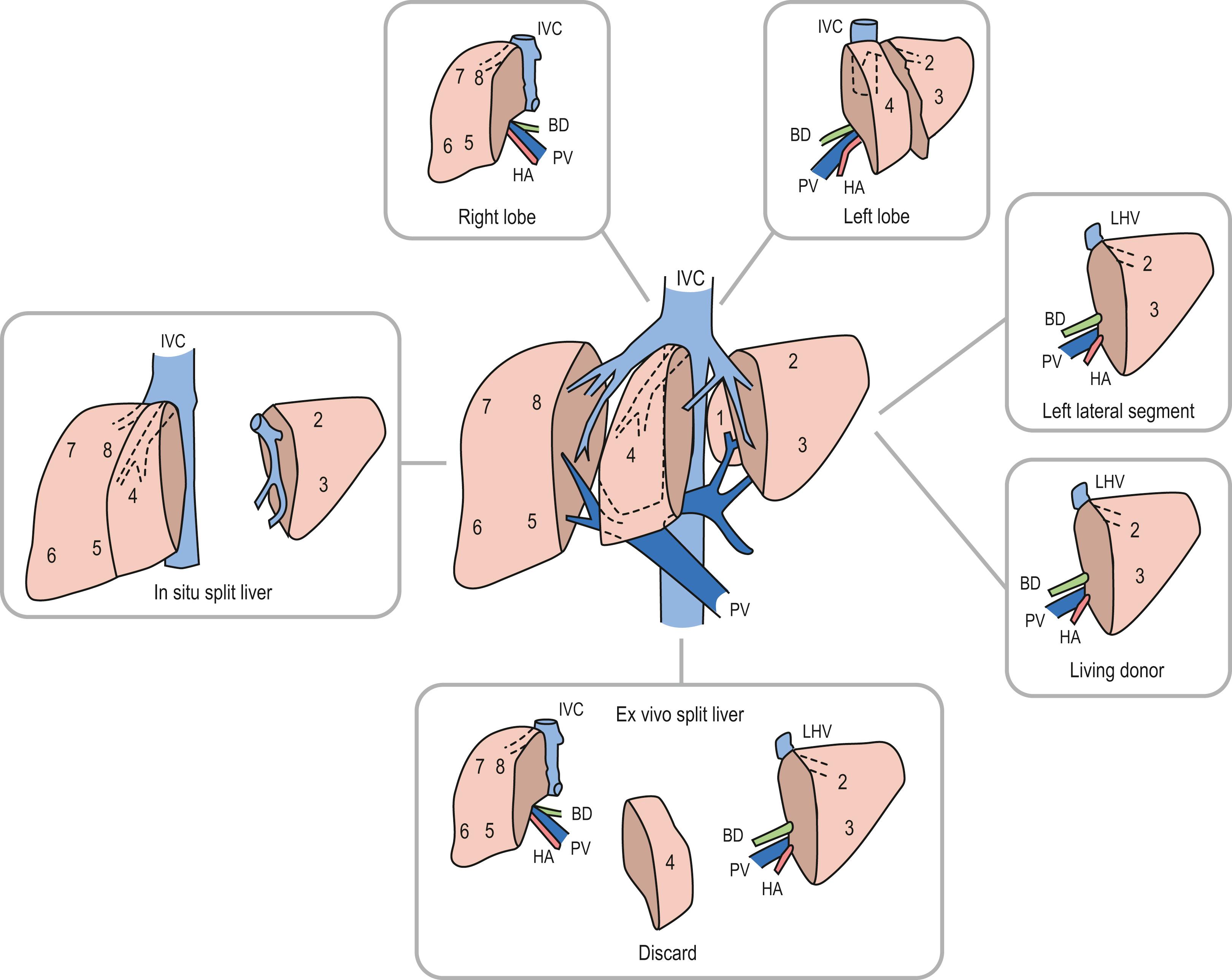
Efforts to correct abnormalities noted during candidate evaluation decrease both the operative risk and postoperative complications. Complications of portal hypertension and malnutrition are treated. Assessment of prior viral exposure and meticulous attention to the delivery of all normal childhood immunizations, particularly the live-virus vaccines, are imperative before LT, if time allows. Additionally, patients receive a one-time inoculation with pneumococcal vaccine and appropriate administration of hepatitis B vaccine. Preoperative assessment of cardiopulmonary reserve and hepatic vascular anatomy is also important.
The transplant procedure is carried out through a bilateral subcostal incision with midline extension. Meticulous ligation of portosystemic collaterals and vascularized adhesions is necessary to avoid slow but relentless hemorrhage. Dissection of the hepatic hilum, with division of the hepatic artery and portal vein above their bifurcation, allows maximal recipient vessel length to be achieved. The bile duct, when present, is divided high in the hilum to preserve the length and vasculature of the distal duct in case it is needed for primary reconstruction in older recipients. Preservation of the Roux-en-Y limb in BA patients who have undergone Kasai portoenterostomy simplifies later biliary reconstruction. Complete mobilization of the liver, with dissection of the suprahepatic vena cava to the diaphragm and the infrahepatic vena cava to the renal veins, completes the hepatectomy.
In children with serious vascular instability who cannot tolerate caval occlusion, or when an LLS graft is being used, “piggy-back” implantation is necessary. In this procedure, the recipient vena cava is left intact and partial caval occlusion allows end-to-side implantation of a combined donor hepatic vein patch. Access to the infrarenal aorta to implant the celiac axis of the donor liver or iliac artery vascular conduits, provided by mobilizing the right colon and duodenum, is our preference for arterial reconstruction in complex allograft recipients.
Control of hemorrhage is essential during the recipient hepatectomy, requiring meticulous technique. Coagulation factor assays (V, VII, VIII, fibrinogen, platelets, prothrombin time, partial thromboplastin time) allow specific blood product supplementation to improve clotting function. Use of venovenous bypass is reserved for recipients >25 kg who demonstrate hemodynamic instability at the time of venous interruption.
In standard LT, the suprahepatic vena cava is prepared by suture ligation of any large phrenic orifices and creating one caval lumen from the confluence of the inferior vena cava and hepatic vein orifices. The donor liver is implanted using conventional vascular techniques and monofilament suture for the vascular anastomosis. In small recipients, interrupted suture techniques, monofilament dissolving suture material, and a “growth factor” knot has been used to allow for vessel growth. When LLS grafts are used, the left hepatic vein orifice is anastomosed directly to the anterolateral surface of the infradiaphragmatic inferior vena cava using the combined right middle hepatic vein orifices. The LLS allograft is later fixed when necessary to the undersurface of the diaphragm to prevent torsion and venous obstruction of this anastomosis. Similar fixation is not necessary with right or left lobe allografts or whole organ transplants.
Before completing the vena caval anastomosis, the hyperkalemic preservation solution is flushed from the graft using 500–1000 mL of hypothermic normokalemic intravenous (IV) solutions. In reduced-size allografts and small recipients in whom we prefer direct aortic vascular inflow reconstruction, the hepatic arterial anastomosis is completed before the portal vein anastomosis to improve visibility of the infrarenal aorta without placing traction on the portal vein anastomosis. We prefer to complete all anastomoses using vascular isolation before organ reperfusion, although some transplant teams reperfuse after the venous reconstruction is complete.
Before reestablishing circulation to the allograft, anesthetic adjustments must be made to address the large volume of blood needed to refill the liver, as well as hypothermic solutions released upon reperfusion. Inotropic support using dopamine (5–10 mcg/kg/min) also may be started. Calcium and sodium bicarbonate are administered to combat the effects of hyperkalemia from any remaining preservation solution or from systemic acidosis due to aortic and vena caval occlusion. Sufficient blood volume expansion, administered as packed red blood cells to raise the central venous pressure (CVP) to 12–15 cmH 2 O and the hematocrit to 40%, minimizes the development of hypotension on unclamping and prevents dilutional anemia. Cooperative communication between the surgical and anesthesia teams facilitates a smooth sequential reestablishment of vena caval, portal venous, and then arterial recirculation to the allograft.
Biliary tract reconstruction in patients with BA or in those weighing less than 25 kg is achieved through an end-to-side choledochojejunostomy using interrupted dissolving monofilament sutures. A multifenestrated Silastic internal biliary stent is placed before completing the anastomosis ( Fig. 45.5 ). In most cases, the prior Roux-en-Y limb can be used, with a 30- to 35-cm length being preferred. Primary bile duct reconstruction without stenting is used in older patients with whole organ allografts.
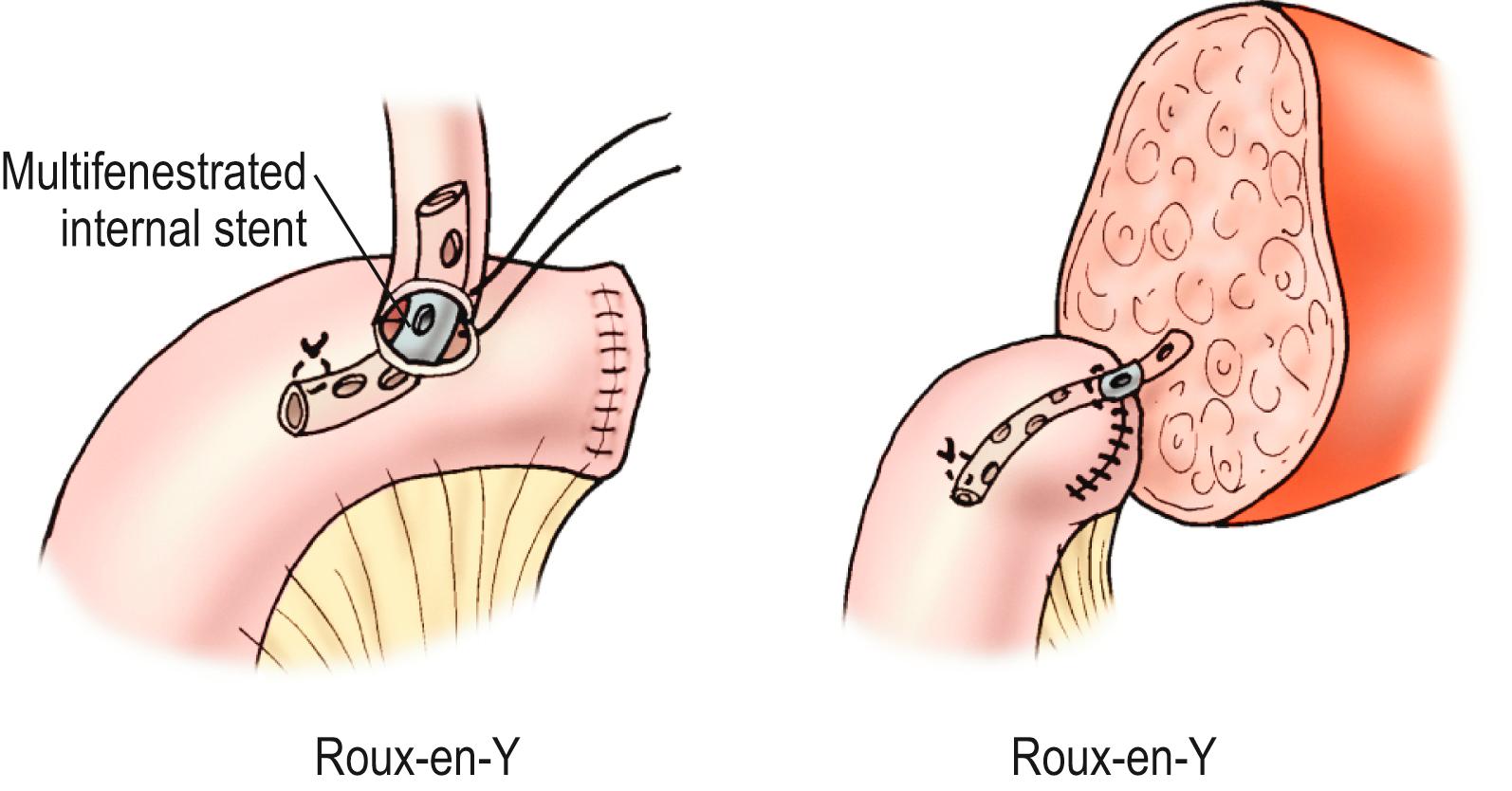
When closing the abdomen, increased intra-abdominal pressure should be avoided. In many cases, the abdominal fascia is not closed and mobilized skin flaps and running monofilament skin closure are used. Formal musculofascial abdominal closure can be completed within 5–7 days after the transplant procedure.
Most centers use an immunosuppressive protocol based on the administration of multiple complementary medications. All use corticosteroids, and most use tacrolimus. Additional antimetabolites (azathioprine, mycophenolate) are added when more intensive treatment is needed. The use of polyclonal or monoclonal induction therapy has become less frequent as the combination is extremely potent and increases the risk of immunosuppressive complications (see later). A sample immunosuppression protocol is given in Table 45.3 .
| Day/Week | Methylprednisolone (mg/kg/day) | Tacrolimus (mg/kg/day) | Tacrolimus Target Level |
|---|---|---|---|
| Intraoperative | 15 | 0 | |
| Day 1 | 10 | 0.3 | |
| Day 2 | 8 | 0.3 | |
| Day 3 | 6 | 0.3 | |
| Day 4 | 4 | 0.3 | 12–18 |
| Day 5 | 3 | 0.3 | |
| Day 6 | 2 | 0.3 | |
| Day 7 | 1 | 0.3 | |
| Week 2 | 0.9 | Adjust as needed | 12–18 |
| Week 3 | 0.8 | ||
| Week 4 | 0.7 | ||
| Week 5 | 0.6 | 8–14 | |
| Week 6 | 0.5 | ||
| Week 7 | 0.4 | ||
| Week 8 | 0.3 | ||
| Week 9 | 0.2 | ||
| Week 10 | 0.1 | ||
| Week 11 | 0.1 | ||
| Week 12 | D/C | 6–12 | |
| >1 year | 3–7 |
Most postoperative complications manifest with increasing hepatocellular enzyme levels, cholestasis, and on occasion fever, lethargy, and anorexia. Therapy directed at the specific causes of the allograft dysfunction is essential. Empiric therapy for presumed complications is fraught with misdiagnoses, morbidity, and mortality. A flow diagram outlining this evaluation is shown in Figure 45.6 .
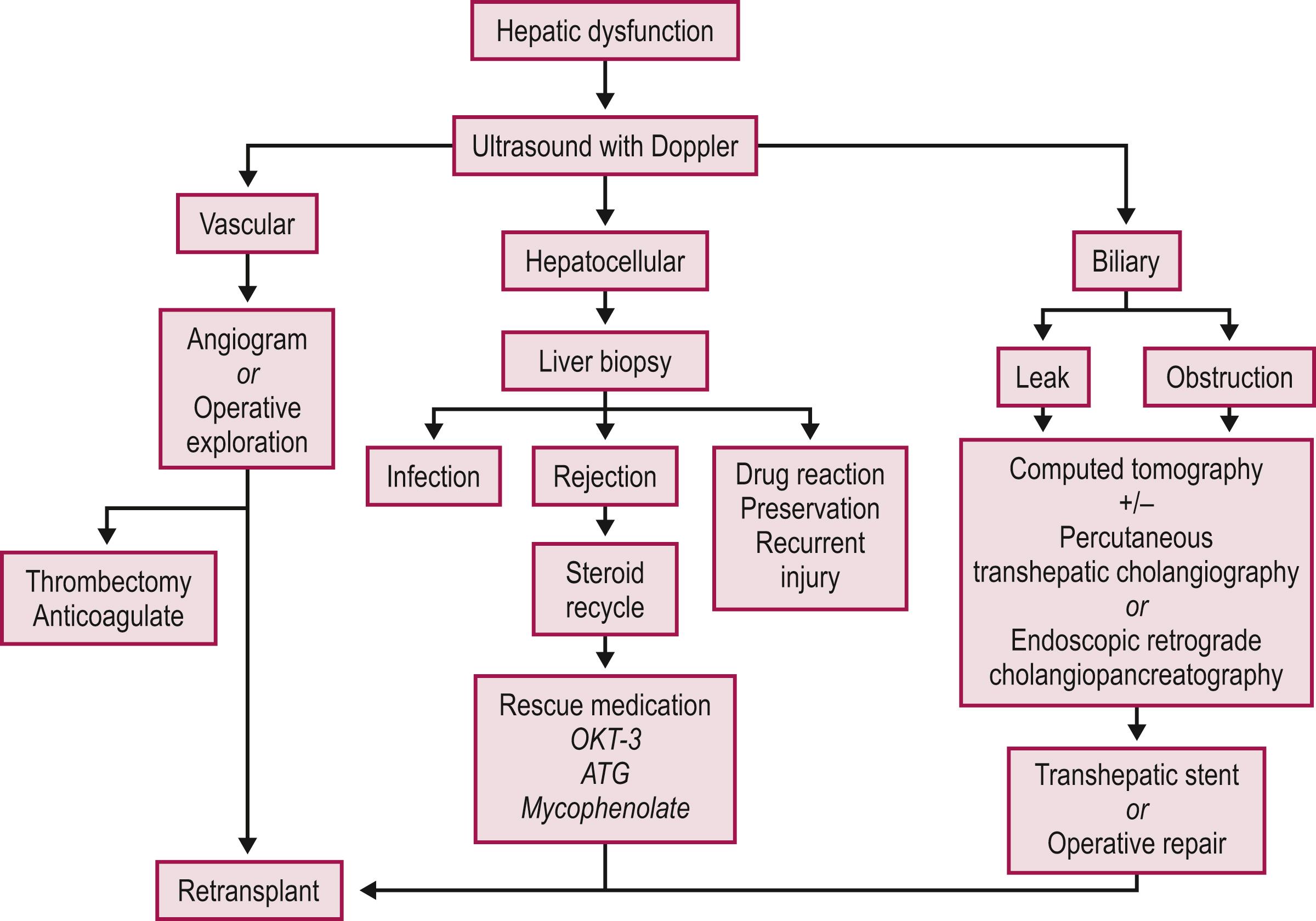
Primary nonfunction (PNF) of the hepatic allograft implies the absence of metabolic and synthetic activity following LT. Complete nonfunction requires immediate retransplantation before irreversible coagulopathy and cerebral edema occur. Lesser degrees of allograft dysfunction occur more frequently and are associated with several donor, recipient, and operative factors ( Box 45.3 ). The status of the donor liver contributes significantly to the potential for PNF. Ischemic injury secondary to anemia, hypotension, hypoxia, or trauma is often difficult to ascertain in the history of multisystem trauma victims. Donor liver steatosis has been recognized as a factor contributing to severe dysfunction or nonfunction in the donor liver. Macrovesicular steatosis on donor liver biopsy is somewhat more common in adult than pediatric donors and, when severe, is recognized grossly by the enlarged yellow, greasy consistency of the donor liver. The risk of PNF increases as the degree of fatty infiltration increases. Histologic findings are classified as mild if less than 30% of the hepatocytes have fatty infiltration, moderate if 30–60% are involved, and severe if more than 60% of the hepatocytes have fatty infiltration.
Preexisting disease or injury to donor, anemia, hypoxia, hypotension before organ harvest
Donor organ steatosis (>60% macrovesicular fat)
Prolonged cold ischemic storage (>8–12 hours)
Prolonged warm ischemic time at implantation
Complex vascular anastomosis requiring surgical revision
Significant size discrepancy between donor and recipient
Postreperfusion hypotension
Vascular thrombosis
Immunologic factors
The use of ABO-incompatible donors has been controversial. Allograft and patient survival rates in adult recipients have not been comparable to those achieved using ABO-identical or compatible donors. However, pediatric recipients of ABO-incompatible allografts have achieved survival rates equivalent to those using ABO-compatible and ABO-identical donors with either cadaveric donors (CDs) or LDs.
Become a Clinical Tree membership for Full access and enjoy Unlimited articles
If you are a member. Log in here